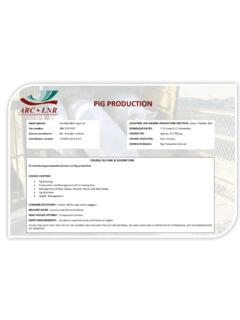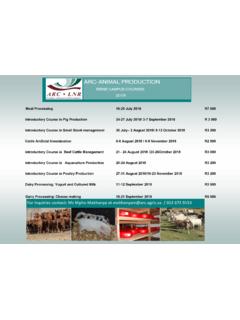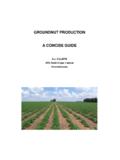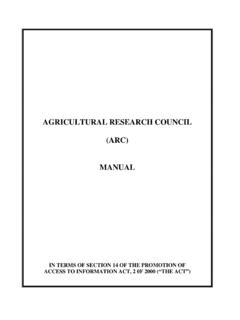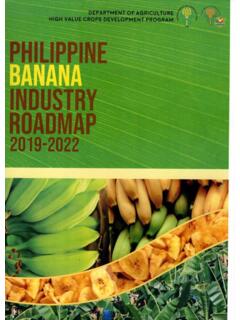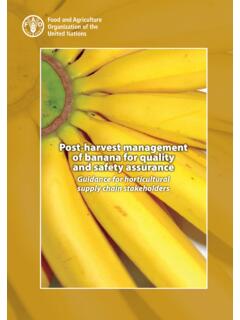Transcription of BANANA PRODUCTION
1 ARC-Institute for Tropical and Subtropical CropsBanana PRODUCTION - EnglishBANANAPRODUCTIONBANANAPRODUCTIONI C ompiled by Directorate CommunicationNational Department of AgricultureandW. Willemse, KwaZulu-Natal Department of Agriculturellustrations by L. Herbst, Mjindi Farming (Pty) LtdText revised byARC-Institute for Tropical and Subtropical Crops, NelspruitTel (013) 753-70002008 Printed and published in the Republic of South AfricaISBN 1-86871-021-1 ARC-Institute for Tropical and Subtropical Crops, Private Bag X11208, Nelspruit, 1200 Tel (013) 753 7000 Fax (013) 752 3854 CONTENTS Planning PRODUCTION ..1 Preparing the land ..7 Planting ..9 Fertilising ..14 Desuckering ..17 Irrigating ..19 Bagging and removing leaves ..21 Controlling weeds ..23 Pest and disease control ..25 Harvesting ..27 Marketing ..311 Planning productionFARMING = BUSINESSPlan your BANANA PRODUCTION well. Farming withbananas is farming for profit2 CALENDAR/YEAR PLANNER How do you plan?
2 Use a calendar or a year planner to organise youractionsDo a soil analysis before planting - take soil samples to see ifnematodes are present and which nutrients are lackingIrrigate, rip, plough, ridge and disc the field. Apply lime, potashand phosphate with ploughingMeasure and start digging holes for plantingPlant, fertilise, irrigate the plants and hoe the weeds3 What actions to plan1. Decide on a cultivar2. Identify where your bananas can be marketed#3. Decide on size of land and spacing between plants# Ask the BANANA Growers Association of SA for advice44. Obtain finance and buy inputs such as fertilisers and tissue culture plants5. Buy land preparation equipment: tractors for ploughing, discing, etc6. Plan labour57. Buy and fetch planting material from a nursery8. Plan how to get rid of weeds9. Maintain and upgrade irrigation equipment and plan irrigation scheduling610. Plan desuckering of the BANANA plants and selection of ratoon suckers11. Plan covering the bunches and propping the plants12.
3 Plan harvesting your bananas13. Plan how to utilise the income7 Preparing the landSoil analysis for lime and phosphate isessential before planting. Add kraalmanure or compost if Fertilise the soil using 4 bags of MAP fertiliser per hectareAdd 2 bags of lime if the pH is low on soil analysis82. Rip the field after fertilising to loosen the soil deep3. Spray or disc if there are many weeds in the field4. Measure the planting distance and dig holes for planting9 PlantingA. Planting method for tissue culture plantsBananas can be plantfed using 3methods:(A) tissue culture plants(B) bits and(C) suckersTissue culture plants are small plants which aregrown from the tissue of the BANANA plant, inbags, and are ready for plantingFor hygiene reasons, this is the preferredmethod for planting bananas1. Prepare for planting by digging holesAdd old kraal manure and put some loose soil back into the holes. Do not add more than 10 g of MAP into each planting hole102. Remove the plastic bag before planting and place the plant in the hole.
4 The soil in the bag must not break up3. Fill the hole with soil round the plant and compact itCheck correct plantingdepth when planting11B. Planting method for bits and suckersBits are small portions of the BANANA plant cut from therhizome (corm) of the plant and a bud is attachedSuckers are shoots growing from the rhizome ofbanana plants and they grow into new plants1. When planting bits, the planting depth must be 10 cm and the bit also about 10 cm2. The planting method for suckers is the same as for planting tissue culture plants12= 2 222 plants/haSpacingSpace the rows 3 m apart and the plants 1,5 m in the rowThe size of the hole must be 30 cm x 30 cm and the depth about kneeheight13Do s and dont s when plantingDo not damage the plant or dislodge the soil whenremoving the bag - use a knife instead of a hoeDo not plant too shallow or too deep and allow a spaceof 10 cm between the plang and the soil surfaceIrrigate the BANANA plants after planting14 FertilisingMake the soil fertile for the BANANA plants afterplanting by applying topdressing1.
5 Apply first topdressing a month after planting (January) using 2 bags of LAN fertiliser per hectare (50 g per plant)2. Apply second topdressing 3 months after planting (March) using 2 bags of LAN fertiliser per hectare (50 g per plant) and 4 bags of KCI fertiliser per hectare (100 g per plant)153. Apply third topdressing 5 months after planting (May) using 4 bags of KCI and 2 bags of LAN fertiliser per hectareDo not apply topdressing in June, Julyand in August4. Topdress again 9 months after planting, in September using 4 bags of KCI and 2 bags of LAN fertiliser per hectare165. Topdress again 11 months after planting (November). Use 4 bags of KCI and 2 bags of LAN fertiliser per hectare6. Apply the last topdressing in January using 4 bags of KCI and 2 bags of LAN fertiliser per hectareMake compost heaps from old vegetable leaves, chicken and kraal manure,which can supplement the fertiliser programme17 DesuckeringDesuckering means cutting off unwantedshoots from the stems of the motherbanana plant1.
6 Use a knife to cut off the stems of the suckers which have grown to about the size of a foot2. When planting on a slope, always leave the suckers which are on the uphill side18NB: It is important to keep not more than 2 222 plants per , after harvesting only 1 sucker should be allowed to grow3. Cut off all suckers which are on the north-western side of the BANANA plant. This is the side where the bunch hangs4. After 5 months from planting, select only 1 vigorous sucker to carry the next bunch. Cut the remaining removing unwantedsuckers as they appearDo not pour diesel over thestems of the suckers, waterthem instead19 IrrigatingWater the BANANA plantsafter planting1. Irrigate newly-planted tissue culture BANANA plants everyday for 2 weeks (15 minutes per irrigation) to protect leaves from heat stress2. In the absence of rain, irrigation water should be applied on a little and often basis to BANANA plants20NB: Find out the delivery rate of sprinkler nozzlesExample: nozzle delivery = 3 mm per hourExample: nozzle delivery = 3 mm per hour3.
7 For heavy loamy soil apply 20 mm of water every 3 days in summer and every 8 days in winterFor every irrigation, run the system for 20 hours divided by 3 hours = 6hours and 40 minutes (20/3= 6 hours, 40 min)For every irrigation, run the system for 12 hours divided by 3 hours = 4 hours and 40 minutes (12/3= 4 hours)21 Bagging and removing leavesCover the BANANA bunches with bags forprotection against insects and wind. Removelower hanging, yellow leaves from the plantCovering the bananas will result in betterquality bananas1. Remove lower leaves from the BANANA plant as they get old because they can spread diseases and scratch the bunch22 Use a knife to cut off old leaves from the BANANA plant - do not pull them2. Old leaves can scratch and damage the fruit on the bunch 3. Cut off the old leaves and place them on the ground - they mulch the surface and increase nutrient content in the soil23 Controlling weedsDo not spray:Control weeds by using:(A) chemical method or(B) hand method or(C) both methodsA.
8 Chemical sprays are used to kill the weeds - use only recommended chemicals and apply these strictly according to the instructions on the label- too much- the BANANA plants- when it is windyWhen using chemical control, such as glyphosphate orparaquat, protect all parts of the BANANA plant fromspray drift24B. Weeds are also killed by using a hoe or by hand, especially in the area near the plant to avoid chemical spray contact with the plantsC. Both methods can be used at the same time to kill weedsRemember to give your BANANA plants support by proppingthe bunches with a rope and sticks25 Pest and disease controlThripsNematodesControl pests and diseases. Differentpests and diseases require differenttreatmentsUse chlorpyrifos pesticide once a month tokill thrips if they are presentIf they are present, kill them withNemacur using 45 kg per hectare (20 gper plant)Compost, kraal manure and chicken manure applied in ample quantities willalso suppress nematodes. Tissue culture plants are free of nematodes26 SigatokaPost-harvest decaySpray with Dithane plus mineral oilDip the BANANA hands into Benlatesolution (5 g Benlate per 10 water) toprevent post-harvest decayl27 HarvestingToo earlyOKToo lateHarvest bananas when they are swollenand green but before they become ripe(plump and yellow)1.
9 Do not harvest too early (when the bananas are thin and dark green) or too late (when they are thick and turning yellow)28 How to harvest1. Get at least 2 people to help you cut the BANANA pseudostem half way across and half way down2. Let the plant fall down slowly and then remove the bunch from it by cutting the bunch stalkChop up the leaves and top part of the pseudostem and lay on the soil as a mulch3. Carry the bunches to the trailer and put them next to each other (not on top of each other)29Do not work alone, always work in pairsDo not let the bunches fall to the groundDo not pack the bunches ontop of each other30 Harvest early in the morningwhen the sun is not too hotDo not leave cut bunches in the sunDo not cut in the hotafternoon unless overcastBuild a packhouse in a cool location to hang bunches,remove hands, cut into clusters, pack into cartons andstore (on southern side)31 MarketingLocal marketMunicipal marketsContractsHome useNow your bananas are ready to betaken to different markets where theycan be soldYou can sell your bananas on thestreets or at a roadside stallYou can arrange with the nearestlocal market to sell your bananasYou can have contracts withsupermarkets and chain storeswhich can buy and sell yourbananas on a regular basisYou can use some bananas for food security at home32 For further information on producingbananas contact the extension officer inyour area
